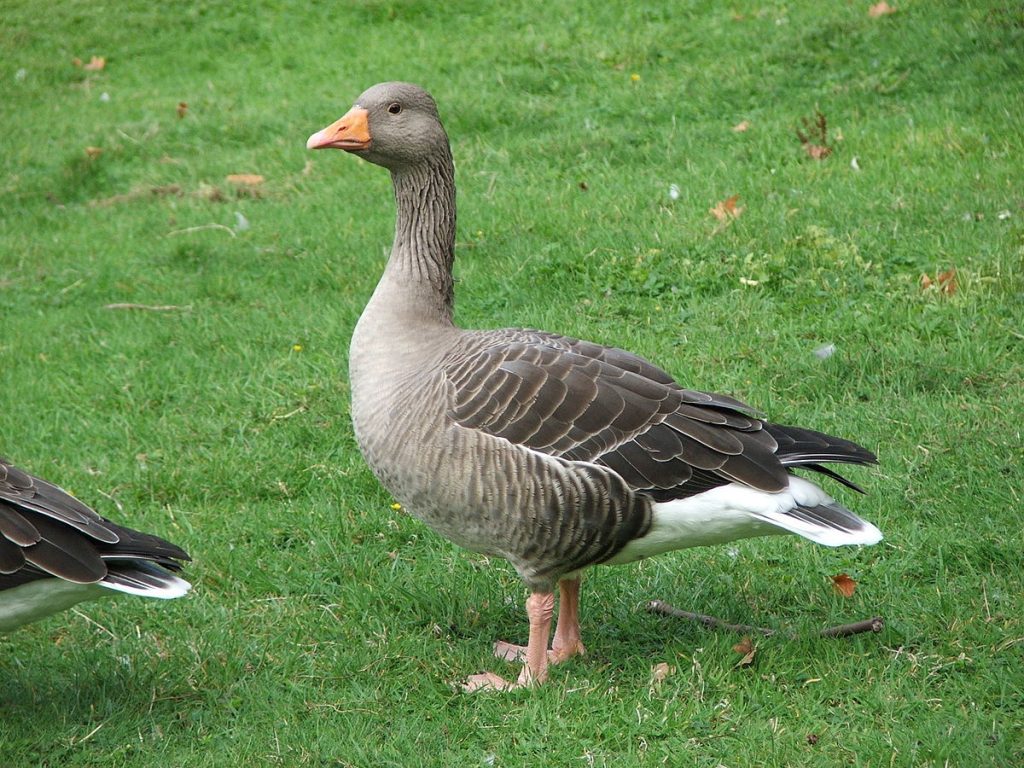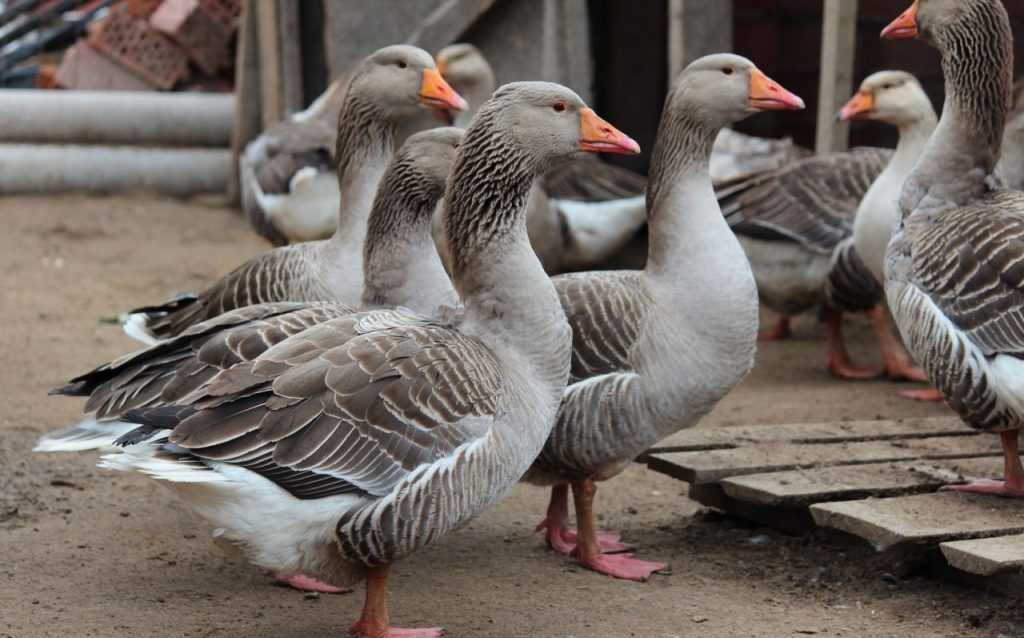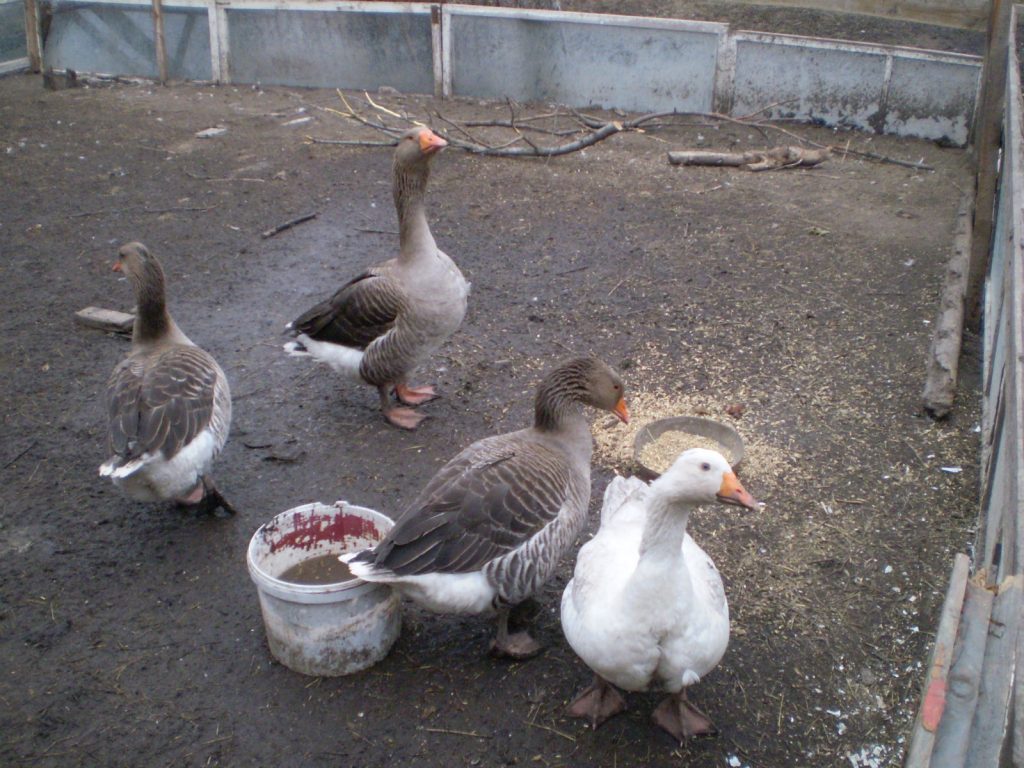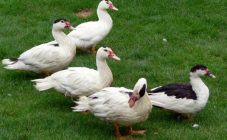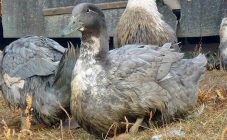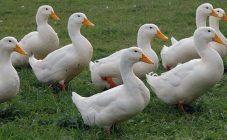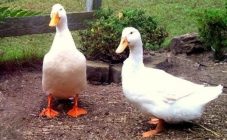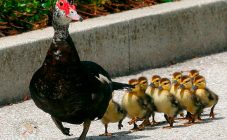Content:
Familiar to every gosling from the yard of their grandmother's village house are actually very interesting poultry. The gray goose is one of the most famous distant descendants of the wild goose. Fun fact: Geese are waterfowl that belong to the duck family.
Goose large gray breed description
Domestic geese almost completely retained the appearance of their founder, and the characteristics of the large gray goose have practically not changed. They are just as powerful and tough, with a large wingspan (about 145-180 centimeters). Wild birds are slightly smaller than the domesticated breed - they are up to 85 centimeters in size and weigh up to 4.5 kg; and especially rare individuals grow up to 90 centimeters and 6.6 kg of weight.
The gray-brown color helps wild species to camouflage themselves in reeds and coastal grass. Despite the fact that gray geese, "domesticated land birds", have become slightly thicker than their wild relatives, they still have:
- wide chest;
- orange or pale red beak with a light tip at the end;
- orange feet with claws and webbing for swimming.
History of the breed
Proud birds have a rich history. Experts believe that the domestication of the wild gray goose began about 3 thousand years ago in ancient states (Egypt, Rome, Greece, etc.). But here it is important to clarify that over the past centuries, everything has changed a lot and modern gray geese appeared due to multiple crossing of different breeds.
A huge contribution to the breeding of these geese was made by the Ukrainian Institute of Poultry. In Ukraine, there are many places with an aquatic environment where a large gray goose could live peacefully. That is why the local Poultry Institute began to crossbreed Toulouse and Romny species to obtain a "base" for a new breed, which still had many transformations ahead. The current breed of gray goose has the following characteristics:
- rather unpretentious to the environment;
- knows how to quickly gain weight;
- distinguished by high quality meat.
During the Great Patriotic War, individuals bred in Ukraine were evacuated to the Tambov region. New transformations awaited the birds here. On the fertile black soil, they set the task: to bring out a breed that could live with minimal amounts of water. Geese had to get by only with water in the drinking bowls. This is how the two most common new breeds appeared - the Tambov steppe and Borkovsky Ukrainian gray geese.
It is also worth noting the subspecies of the Tambov gray geese. Experienced farmers who farm all year round know about the Ural geese, which can easily endure the low winter temperatures. Of the "additional" breeds of grayish large geese, farmers also prefer the Kuban and Bashkir geese. Kuban geese adapt best of all to different weather conditions: they easily endure both frost and sultry wind.
The Bashkir goose is unmatched in the wearing of eggs. Many breeders note that the eggs of white Bashkir geese even have an unusual taste.
Sex determination in large gray geese
Thanks to multiple crosses, gray geese today have a high vitality. The Ukrainian and Tambov geese have a well-developed instinct for hatching eggs. But how can you tell a goose from a gander? How to find out the gender of a chick when buying? After all, different farmers have their own goals. One wants to get a good flock of females and a small number of males for maximum egg production. For another, it is more important to get a large amount of meat from the geese, which means it is more expedient to have males. It is difficult for inexperienced farmers to determine the gender by the appearance of defenseless chicks, so a hint is needed:
- Method 1. Determine the sex by the habits and behavior of the little brood. Despite the same age, geese and geese, even in the form of small chicks, are different from each other. Geese are taller, even if they have an equal mass with the geese, their head is larger and the neck is longer.
- Method 2. Males are much noisier than females. Screaming and restless - these are the liveliest gray guys who even rush to the feeding troughs first. Females, on the other hand, will quietly stand aside and give their voice only during hunger.
- Method 3. With adults, everything is much easier. Females are a whole quarter smaller than males. A special feature in gray geese is the different length of the neck between females and males: the neck of the goose is always shorter than that of the male. If you scare the “herd”, you will notice how the males, because of their instincts, look for danger, giggle, stretching their necks, and the females cautiously huddle to the ground.
Features of breeding gray geese
Farmers mainly plan to raise gray geese for further consumption, because goose meat is quite tasty and healthy, and is also filled with whole groups of vitamins (A, B, C) and other useful substances: iron, calcium, magnesium, sodium and others.
Due to the fact that geese walk a lot, their muscles are full of blood vessels, the meat is dark and tough, but it also contains a large proportion of fat. Goose fat contains substances useful for the human body, which are useful for strengthening the immune system and metabolism. Some breeders feed gray geese to get fatty liver.
Gray geese are not only distinguished by their good stamina, useful meat, etc., but also by their reproductive characteristics. Those who have been busy with farming for a long time know that Tambov gray geese are excellent parents under good conditions. In the path of multiple crossing, females have become excellent brooders.
Separating the goose from the rest of the birds / relatives, you should give it a separate place to incubate the eggs. At the same time, it is necessary to provide quality nutrition with the addition of dairy products, namely yogurt and cottage cheese. It is under such good conditions that the owner will receive up to 15 strong and healthy chicks from one clutch.
Small chicks are first fed with a "porridge" of boiled eggs and cottage cheese. As they grow older, they are added grains of wheat, corn, preparing them for adult nutrition. In the village, they often practice fodder from compound feed, cucumbers, and nettles. Such food ideally expands the diet, since geese feed on both fresh grass (up to 2 kg per bird per day) and wheat.
Features of the content
Gray geese are not too whimsical to the presence or absence of water bodies. This bird lives in different ways for different breeders: in someone's pen, at someone by a river, in a meadow. When choosing a reservoir for the removal of a flock for the whole day, you need to take into account that the reservoirs should be clean and with a light current.Meadows and pastures for walking should not be swampy, they should always have fresh grass.
Small barn-like rooms are suitable for gray geese, who are not picky in the home. In such pens, the floor is raised above the ground and covered with straw and sawdust. For wintering, it is necessary to harvest about 35-40 kg of dry grass for bedding, which must be changed every 1-2 days to maintain cleanliness and prevent the development of diseases.
The owner of the yard with experience will always advise a young breeder:
- regularly ventilate the room ("dry" the barn and hay);
- to treat the floor with superphosphate (200 g per 1m²);
- take care of the constant cleanliness of their drinkers and feeders.
With poor care, gray geese can pick up various diseases and sores.
Due to dirty drinking bowls with stagnant water, expired feed, worms can enter the body of geese. In this case, poultry abruptly loses its weight gain and becomes prone to other diseases due to decreased immunity. Going to treat this ailment, it is urgent to identify the "pathogen" and conduct deworming.
Forgetting to fill the drinkers, inexperienced owners can ruin their brood by blocking the esophagus. In this case, experienced owners use a folk remedy with vegetable oil, which in an amount of about 40-50 g is poured into the throat of a sick gander or goose, and then gently press on the esophagus, thus getting rid of the clogging of the esophagus.
With a lack of vitamins, vitamin deficiency may occur. Birds will eat poorly - development and weight gain will slow down. It is easy to deal with the prevention of this disease - it is enough to purchase and add special vitamins to the feed.
Breed advantages and disadvantages
Unpretentiousness to keeping conditions makes gray geese very profitable for keeping in a rural or farm yard.
Positive characteristics of the breed:
- a good level of egg production for a meat breed;
- fast set of useful weight;
- the ability to breed at home by incubating - geese are excellent parents.
Negative points:
- medium quality meat;
- the difficulty of feeding in the winter.
Comparing large gray geese with other breeds, you can identify their clear advantage. With a little care, their unpretentiousness in nutrition and habitat, the farmer will always have a tasty and healthy product: meat and eggs.
